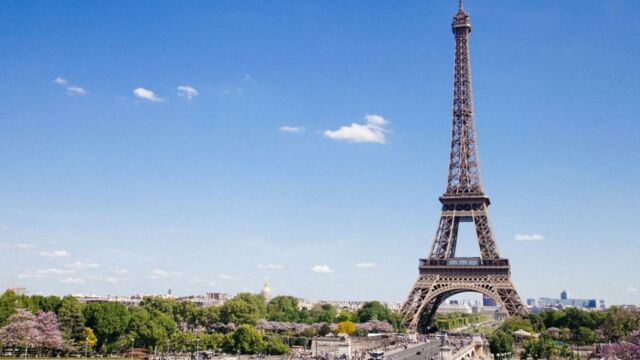Paris and the Eiffel Tower are inseparable. One of the world's most visited and recognizable monuments, it's also a hotbed of anecdotes. Its name, its price tag, its true inventor - you'll know everything there is to know about it. Enough to impress the gallery on your next visit to Paris, or during a dinner party.
Discover our latest podcast
Here are eight little-known facts about one of the most famous towers in the world, and in France of course.
1. The Eiffel Tower should have been called the Bonickhausen Tower
Gustave Eiffel was born Gustave Bonickhausen. One of his ancestors had the name Eiffel added at the beginning of the 18th century, as he came from a region of North Rhine-Westphalia, Germany, known as Eifel. Gustave's ancestor had chosen this name, which sounds better in France, especially when you work in business, when he moved to Paris. Although the two names coexisted, Gustave separated from them to take the name we know today: Gustave Eiffel.
2. Gustave Eiffel did not invent the Tower
The original idea for the Eiffel Tower came from two engineers working for Gustave: Maurice Koechlin and Émile Nouguier. They imagined and designed the prototype. OK, so why does the Eiffel Tower bear his name? Because Gustave was well-connected with the powers that be, he helped finance it and bought the patents from the two engineers.
Read more:Windsor Castle: Discover the legend of Bloody Mary
3. It was the world's tallest tower for 41 years
When it was built, the 300-metre-high Eiffel Tower was the world's tallest building. Defeated in 1930 for 19 metres by the Chrysler Building in New York, it is now tiny compared to the 828-metre Burj Khalifa in Dubai, United Arab Emirates. Since the beginning of the 20th century, the Eiffel Tower has grown a little taller with its installations at the top. Its current height is 324 metres.
It is also the world's busiest paying tower. Cock-a-doodle-doo!
4. The Eiffel Tower was meant to be ephemeral
Yes, the Eiffel Tower was to be dismantled a few years after the Universal Exhibition. It was supposed to showcase French savoir-faire. It has to be said, however, that this huge pile of junk did not go down well with the men of Arts and Letters. An open letter published in the newspaper Le Temps and signed by Charles Gounod, Guy de Maupassant, Emile Zola, Victorien Sardou and Alexandre Dumas' son, among others, violently protested against the construction.
In the end, Gustave Eiffel campaigned to renew the concessions. He found functions for the Eiffel Tower (meteorological functions, a TSF test laboratory and a relay antenna), eventually staying the course and becoming the 7th most visited monument in the world (far behind Beijing's Forbidden City and the Château de Versailles).
5. The Eiffel Tower has been sold to two scrap merchants
Of course, ephemeral means dismantling. And faced with 7,300 tons of metal framework, the scrap merchants thought it was a good idea. The year was 1925. A swindler by the name of Victor Lustig approached the scrap merchants, saying that the Eiffel Tower was for sale (but that it was top secret) because it was too expensive to repair. And, of course, the contract would go to the highest bidder. Two were generous, and Victor Lustig made off with the loot. As for the victims, they were too ashamed to press charges.
What's more, and this is no scam, whole pieces of the Eiffel Tower are sometimes changed to avoid the effects of time on the metal. And auctions to snatch up a piece of Eiffel Tower are held... sometimes.
Read more:If you don’t think about the Roman Empire often, you might after reading these crazy facts
6. The Eiffel Tower is tricolored
Yes, I know, it looks like a uniform shade of brown against the Champs de Mars sky. But to look uniform, you have to shade it, whether you're at the foot of the Eiffel Tower or at the top. And you have to slather dark brown on the ground and offer a lighter shade at the top. In fact, the Eiffel Tower wasn't always brown. It has had many shades: red, yellow, blue, brown... For your information, it takes 16 tons of paint to repaint it. So remember to order in advance from your local shop!
7. The Eiffel Tower is worth 434 billion euros
We owe this estimate to an Italian chamber of commerce, which gave the building's heritage value in 2012.
For the record, the Eiffel Tower cost 7,799,401 gold francs to build in 1889. I sense you're confused: it would cost more than 32 million euros these days. 32 million euros to build an iron tower...
But given the recent improvements in the construction sector, if you wanted to put a life-size reproduction of the Eiffel Tower at the bottom of your (large) garden, it would cost you 28 million euros: 1 million for materials and the rest for labour.
We don't know the exact number of copies, replicas and buildings largely inspired by the Eiffel Tower, but there are at least thirty of them around the world.
8. The Eiffel Tower is married
It's hard to believe that this information is true, but it is. In 2007, an American woman, Erika LaBrie, got married to the Eiffel Tower. Having always felt a special connection with objects, Erika LaBrie, now Erika Eiffel, discovered Paris and thus the famous tower in 2004.
And it seems that the connection was made quickly, as the American immediately felt a strong attraction to the object. Three years later, she was married at Paris' most famous landmark.
Read more:The sinister story of the Radium Girls, the women who worked in clock factories during WWI
This article has been translated from Gentside FR.















